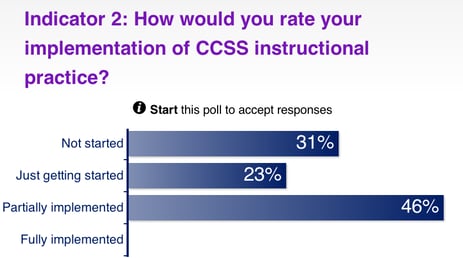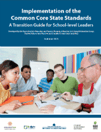
A few of us from Insight just got back from a great week with our charter friends at the California Charter School conference.
As expected, the week was filled lots of conversation and questions (including some anxiety) around the Common Core. What technology should be bought? What curriculum resources are needed? What does it really look like to teach with the new standards?
One of the highlights of the conference for us was a presentation we (Michael and Jason) led called Common Core Track 201: Curriculum and Professional Development. Although not a terribly exciting title, we knew these two topics were critical issues that schools and districts in California (and nationwide) are wrestling with and trying to figure out.
In way of background, last year the Aspen Institute pulled together a group of organizations, including Insight, to develop a toolkit entitled Implementation of the Common Core State Standards: A Transition Guide for School-level Leaders. In it, the toolkit guides leaders through seven indicators (or action steps).
We focused on three of the seven toolkit indicators in the presentation, including:
- Instructional practice
- Ongoing professional Learning
- Instructional resources
In our next few blog posts, we're going to share some highlights from the presentation for those of you were unable to make it. Here's the first of three posts.
Where do we begin with establishing common instructional practice expectations for the Common Core?
The impact of the Common Core standards on instruction is not insignificant. In fact, it’s all about instruction.
To gauge where our audience of charter teachers and school leaders was in terms of implementing CCSS instructional practice, we did an informal poll asking them how they would rate their schools in this indicator. Here's what they said.

While it was a small sample (about 20 educators), we’ve found that the results are indicative of what what’s happening across California (and in the rest of the country, too).
Almost everyone has started “implementing” the Common Core. However, the field is still learning about what high-quality Common Core instructional really looks like. So, it should be no surprise that implementation of the standards is a loaded concept. It’s likely going to take a few years to really understand what it means to effectively implement the new standards.
A few recommendations for getting started
Here are a few recommendations we shared with the audience.
STEP 1. Create common expectations for CCSS-aligned instructional practice.
After establishing a team of classroom teachers and administrators (see indicator 1 in the toolkit), create, adapt, or adopt a set of common expectations for what CCSS-aligned instructional practice looks like.
The leadership team:
3. Clearly communicates the purpose of these aligned tools to teachers.
Supported by the leadership team, staff members then utilize data from observations and coaching feedback to inform and continuously improve classroom practice.
STEP 2. Consider key instructional practice issues when it comes to CCSS.
Issue 1. Consider the use and purpose of observation tools.
- Will they be used for coaching, evaluation or both?
- How often will they be used?
- And by whom?
Issue 2. Take a look at the explicit alignment of tools to Common Core.
- Use a framework (like the Insight Core Framework).
Issue 3. Consider the number of tools being used by different stakeholders in the process.
- Schools and districts across the country have found multiple ways to engage teachers and school leaders in the development of tools intended to provide both direction and support.
- Check out the frameworks of a few districts who are deeply immersed in this work:
STEP 3. Heed a few lessons learned from other schools and districts.
Lesson 1. Explicitness matters! Levels of performance must be articulated so educators know what “great” vs. “poor” performance looks like relative to expectations.
Lesson 2. Teachers need examples of what “great” practice for each expectation looks like. As school leaders, we need to get into the mindset of growth vs. gotcha. Framing the use of observation tools is critical for positive implementation.
Lesson 3. "But I don’t have time!" Instructional leaders must regularly use observation tools. Leaders cannot divest responsibility for supporting teachers and holding them accountable for instructional expectations. This becomes “the work” of leaders.
A First Step
 With your leadership team, take some time to do a CCSS implementation self-assessment to identify your key questions or next steps.
With your leadership team, take some time to do a CCSS implementation self-assessment to identify your key questions or next steps.
Although this is new territory for us all, there are definitely some great tools becoming available to help with your transition to the new standards.
Remember, short- and long-term planning, as well as patience, will be key to the success of this effort.
Our job should focus on ensuring that teachers feel supported in this process. Making time for collaboration, discussions on the success and challenges, and consistent feedback will all play a key role in helping to create classrooms in which students are challenged by the new standards.

